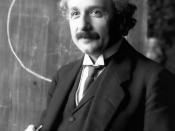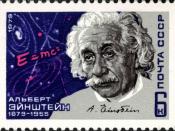Antimatter, commonly referred to as ÃÂthe mirror image of matterÃÂ, is a bit of an enigma; the majority of the universe is made up of it, yet we cannot see it. It is nearly identical to the matter we interact with everyday, but if they come in contact both are totally annihilated. It can provide the most efficient fuel possible, allowing humankind to explore worlds that otherwise would be unreachable. Yet it can even more destructive than the most powerful atomic bomb. (Hogan) (Newham)The idea of an antimatter particle was first conceived as the result of attempts to extend and unify past theories, most notably, those of Albert Einstein and Max Planck. In 1905, Albert Einstein published his theory of Special Relativity. The equation ÃÂE=mc^2ÃÂ, defining a relationship between mass and energy, comes from this theory. Max Planck researched the properties light. Planck rejected the widely held idea that light existed in the form of waves; matter existed in the form of particles, and that there was not relationship between the two.
Planck instead theorized that light was made up of small ÃÂpacketsàof energy, which he dubbed ÃÂquantaÃÂ, possessed the qualities of both waves and particles. Erwin Schrödinger continued experimenting throughout the 1920s with the wave/particle duality. In 1926, he developed the Schrödinger Equation to describe the effects of space and time on quantum systems. However, SchrödingerÃÂs Equation did not account for EinsteinÃÂs theory of Special Relativity, and could not be applied to objects traveling in fast, relativistic velocities near the speed of light.
(ÃÂAntimatter: Mirror of the UniverseÃÂ)From this perplexity, the knowledge of antimatter particles was born. In 1928, English physicist Paul Dirac created an equation that combined quantum theory and special relativity to describe the behavior of an electron. DiracÃÂs equationÃÂs worked, but it often...


